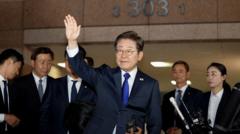In a recent escalation of tensions surrounding the fragile trade agreement between the United States and China, Chinese officials have firmly dismissed claims made by President Trump that China failed to comply with the terms of the 90-day trade truce. China's Ministry of Commerce responded on Monday, asserting that the real damage to the agreement has stemmed from the U.S. introduction of “discriminatory restrictive measures.”
China Responds to Trump's Trade Accusations, Counterclaims Discrimination

China Responds to Trump's Trade Accusations, Counterclaims Discrimination
In a swift rebuttal, China defends its adherence to the recent trade truce while accusing the U.S. of discriminatory practices.
The trade truce, reached following a meeting in Geneva, was intended to ease trade hostilities between the two nations, allowing more time for negotiations and averting an all-out trade war. Last week, President Trump took to social media to accuse China of not living up to its commitments, prompting an immediate response from Chinese officials. They labeled Trump's accusations as “baseless” and argued that the U.S. had severely undermined the truce through its own actions.
In their statement, the Chinese Ministry detailed a series of measures that it deemed erroneous, including restrictions on chip design software exports to China and limiting American firms from engaging with or financing technologies from Huawei. Additionally, the Ministry condemned the Trump administration's intentions to revoke visas for Chinese students and intensify scrutiny for incoming Chinese applications, insinuating these actions were unilaterally aggravating trade tensions.
The statement reiterated that China was committed to honoring its agreement and would take necessary steps to “safeguard its legitimate rights and interests” should the U.S. continue its harmful approach. The growing discord over the trade situation has raised concerns about the feasibility of cementing a lasting agreement before the truce reaches its 90-day expiration.
Amidst these tensions, U.S. officials have reported worries about a potential shortfall in access to essential materials, particularly rare earth magnets vital for the production of technology and transport sectors, as China holds a critical monopoly over this market.
Jaimeson Greer, the U.S. trade representative involved in negotiating the agreement, suggested on a CNBC segment that compliance from China has been "slow-rolling," with expectations for a return to normalcy in critical mineral trade still unmet.
The truce established on May 12, which lowered tariffs from previous high levels—145 percent from the U.S. and 125 percent from China—to 30 and 10 percent respectively, may still find itself challenged as both nations navigate these complex and volatile economic waters.
In their statement, the Chinese Ministry detailed a series of measures that it deemed erroneous, including restrictions on chip design software exports to China and limiting American firms from engaging with or financing technologies from Huawei. Additionally, the Ministry condemned the Trump administration's intentions to revoke visas for Chinese students and intensify scrutiny for incoming Chinese applications, insinuating these actions were unilaterally aggravating trade tensions.
The statement reiterated that China was committed to honoring its agreement and would take necessary steps to “safeguard its legitimate rights and interests” should the U.S. continue its harmful approach. The growing discord over the trade situation has raised concerns about the feasibility of cementing a lasting agreement before the truce reaches its 90-day expiration.
Amidst these tensions, U.S. officials have reported worries about a potential shortfall in access to essential materials, particularly rare earth magnets vital for the production of technology and transport sectors, as China holds a critical monopoly over this market.
Jaimeson Greer, the U.S. trade representative involved in negotiating the agreement, suggested on a CNBC segment that compliance from China has been "slow-rolling," with expectations for a return to normalcy in critical mineral trade still unmet.
The truce established on May 12, which lowered tariffs from previous high levels—145 percent from the U.S. and 125 percent from China—to 30 and 10 percent respectively, may still find itself challenged as both nations navigate these complex and volatile economic waters.






















